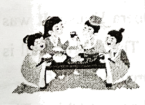What kind of shoes do you wear most? Perhaps leather shoes or sports shoes. But Chinese people used to wear hand-made cloth shoes.
It’s said that ordinary people were not a
With o
相似题推荐
What comes to your mind when you think of Beijing? The Forbidden City? Tian’anmen Square? The Temple of Heaven?
These f
The central axis means the ‘line’ that separates the e
The central axis is like the backbone (脊梁) of Beijing. It smartly arranged the palaces, temples, markets and streets in a
The central axis shows the traditional Chinese concept of ‘respecting the center’. This stressed the i
The central axis also shows traditional Chinese i
‘The unique and magnificent spatial order of Beijing was generated by this central axis,’ said an architect.

Did Chinese people in the p
Still, during these times, some rich people had three meals a day. But poor people didn’t u
Three meals a day became common d
Long ago, the n
The Spring Festival is the most important holiday for Chinese people. On that day, people would come back home and get together
Before the Spring Festival comes, people do lots of preparations like cleaning the rooms and
Spring Festival Eve is the most important. At that time, all family members eat dinner



